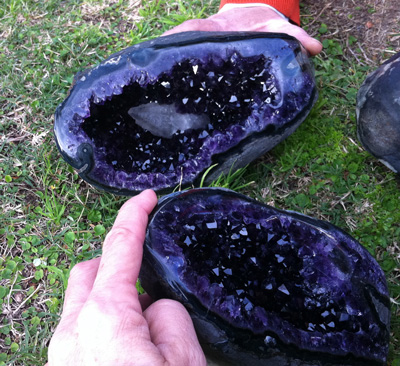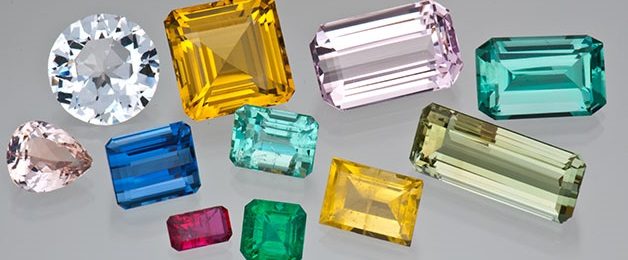An exclusive interview for “The World of Gems” with an expert on Uruguayan Amethysts, Carlos Espejo
What a beautiful country Uruguay is! I’ve been here for about a week and am constantly surprised by the spectacular beaches on the Atlantic Ocean, endless green meadows, beautiful horses, delicious food and hospitable people. I felt like a stranger only for a moment. The people here have made me feel like one of them. The country is large and rich in gems and because I am a lover of the same, I wanted to gain an insight into the gem this country is most famous, Uruguay Amethyst.
To find out more I met with the geologist and Amethyst expert Carlos Espejo. Carlos is a Uruguayan native, an “Artigueño”, that is, he comes from the province “Artigas” where the Uruguay Amethyst originates. I was a little nervous to meet someone who has devoted his life to the study and mining of amethysts and whom is “the” expert in this area.

Carlos Espejo Interview
With our first handshake, all my doubts and uncertainties vanished! Carlos is a friendly and sociable man who talks about his knowledge without ostentation.
What I noticed about him immediately, was the calmness with which he moves between the fabulous Amethyst Geodes. Never before in my life have I seen such geodes! For our interview we sit comfortably in the park.
Please clarify your profession, Carlos
“For over 40 years I have been excavating amethysts – in the ” Canteras “(quarries). I work with a team consisting of geologists and miners. Buyers, prospective customers and collectors from around the world come here to purchase amethysts – also because they now all know me well.”
What does an Amethyst search entail exactly?
“You need a state permit. This is a license that must be renewed regularly. To get them, you must prove that you have the qualifications and that everyone on site has the knowledge and is able to do this job. With this approval, we are then authorized to rent and to work on a particular section of land, enabling us to look for amethysts which we can harvest. This plot of land is called a “Cantera”. You need to know that from a depth of 30 centimeters the land is the property of the state, not the owner. We also rent a piece of land from the owner. A fence is pulled around this land, in order to prevent livestock or other animals from walking around the grounds. Finally we can begin searching for Amethyst. We begin either with an open pit or we dig a tunnel when we need to go through mountains or hills. As you can imagine, you really need to know what you are doing because we “pierce” the country and sometimes must work with explosive materials. I personally prefer the open pit.”
How should I interpret that?
“One begins to dig until one encounters traces of Geodes or Druze. Sometimes Days and weeks pass without result and sometimes you find one day wonders… If you find geodes in larger dimensions, you have to carefully knock around the Geode, the Geode must not be destroyed. It takes a lot of patience, skill and professionalism to take out the Geode as a whole – without it breaking apart. To a remove 4000 or 5000 kilos of Geode from the earth, you need up to six months’ work. Large geodes are the exception. It is imperative that the “Cantera” must re-filled with earth once you have finished working on a field. This prevents the environment from suffering degradation. For example, we must re-fill holes that cattle could easily to fall into.”
How many “Canteras” are there nowdays in Artigas?
“Today, there are 58 Canteras, which are active. Both amethyst and agate are mined there.”
What is the most interesting feature of the Uruguay amethyst?
“The intensity of its colour, of course!”

Amethyst geodes
While Carlos tells me all this, he shows me a Druse, which is 60 cm long and about 50 cm wide. In its interior you can see the individual Amethyst crude crystals. They have a perfect colour and an exceptional transparency – dark, intense violet. Carlos smiles as he sees my astonishment and with the certainty of someone who can read minds, he says: “Imagine this is before one of those amethysts is cut and ground. You’re thinking how beautiful they will be as the raw material is already so amazing… right? “
Tell us, Carlos, is it common to find Amethysts in such high quality?
“The so-called “bochas” (closed geodes), show Amethyst crystals of intense colour and a perfect crystallization, and are found only very, very deep in the terrain. The whole intact Geode is dug up and divided with a lot of care into two parts. The slightest mistake can damage the crystals. This is a job that requires a lot of concentration and experience. Sometimes you experience surprises, such as when the Geode includes material that you did not expect. Less than 2% of all Geodes Amethyst crystals include such colour tonality and transparency. Typically, the outer “envelope” or “shell” of a Geode, which includes the intense purple amethysts, is made of basalt.”
Carlos shows me a bipartite Geode with basalt bowl. Inside there are stunningly beautiful amethyst crystals to see. The perfection of the crystal is incredible. You could take it as it is and perhaps add a silver or gold border. Carlos reads my mind again – now I am sure that the guy that actually can! – And shows me what I had just imagined: a raw amethyst in a gold pendant. With an open view Carlos says: “Never forget that the work of which I have just spoken, is purely artisinal in nature. We have help from tools that provide accuracy, but it always is hand work. Concerning the quality of amethysts: there are also lighter amethysts, which present a very good crystallization and have a graceful beauty. The best quality amethyst can be found only a few feet underground. I firmly believe in the power that is transmitted through these gems.”

Amethyst with Agate
Carlos shows me yet another Geode. In this case, it is a smaller version, with a nice bowl of agate. Very eccentric geological phenomena have made this corner of the world an agate and amethyst paradise. Carlos shows me another small wonder of nature, a geode with an interior of bright amethyst crystals accompanied by black tourmalines. These rocks are of improbable beauty. Carlos tells me that collectors visit him regularly from around the world looking for such treasures.

Amethyst and agate geode
“One day,” – he continues – “I fulfilled a desire of my mother. She is a woman who has an eye for detail and our house, where we are born and raised was furnished with good taste. I have completely paved the floor in the entrance with Amethyst. You cannot imagine Cuini, how beautiful it looks and how happy and proud my mother was when she saw the finished work!”

In an interview with Carlos Espejo
I’m still overwhelmed by the beauty of these geodes and very impressed with my interviewee. Carlos has told everything with humility and patiently answered all my questions. He has generously given me a small portion of his time. But generosity is one of his virtues. He held honorary lectures in countless schools for children and adolescents in Uruguay for years. Carlos sees a need. He tells me that Uruguay has its treasures of gems recognized correctly and never interpreted. Only in recent years – thanks to the popularity of the Uruguay amethyst on the international gemstone market have people become a bit more attentive. “But there is still much to do” says Carlos. “One must encourage this attention. You have to learn that, what comes out of the earth is precious and must be valued and protected.”

Amethyst with calcite and black tourmaline
I say goodbye to Carlos Espejo, thank you very much for the interview! I am still touched by his knowledge and modesty, both of which he shares. With the latest images of this country in my mind I get on the plane to Berlin.
Adios Uruguay! I hope to see you again soon!
Browse our the breath-taking jewellery set with Uruguayan Amethyst only at Rocks & Co >






